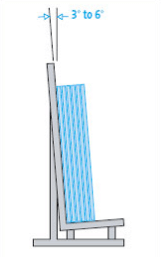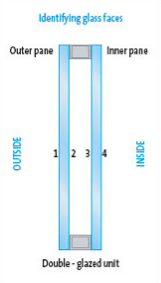Storage And Handling
Upon the delivery of the glass check marks and labels on the crate, pack or glass to ensure compliance with the specification.
The edges and corners of glass and double-glazed units are especially vulnerable during handling, storage and installation. Inspect the cut edges of the glass for excessive flaws such as shells or feathers that can compromise the strength and mechanical performance of the glass.
Check all surfaces for any signs of mechanical damage or etching. Particular care is necessary as edge or surface damage may cause subsequent unexpected failure.
Glass that is not stored safely can present considerable risk of injury.

NEVER STACK GLASS PANELS HORIZONTALLY
Store panels on edge at an angle of 3° to 6° from the vertical, with sufficient lateral support to prevent bowing, in a clean dry, ventilated place, avoiding direct sunshine and other sources of heat. Set the glass panes on strips of wood or other soft material, to avoid contact with hard materials such as metal, stone or concrete. Avoid contact with alkaline materials such as lime and cement.
Delivery, handling and site storage methods must be agreed for each site. Any form of factory applied protection, such as cork pads or shrink-wrapping, must not be removed until the glass is ready for installation.
When the packaging has been removed, the glass must be covered to prevent the ingress of dust and grit that may cause subsequent scratching.
Glass is not normally considered corrodible by contact with water providing it is allowed to dry properly.
However, if water is allowed to remain in contact with the glass for extended periods it can become alkaline and will attack the glass surface. If not stored properly water can penetrate between panes of stacked glass by capillary action; this moisture is then trapped between the panes and will tend not to dry naturally, eventually “welding” the glass sheets together.
If any moisture or condensation is apparent between the panes of stacked glass, separate immediately and dry thoroughly, otherwise permanent staining may result. Re-stack in a more suitable location in accordance with the advice provided above and the recommendations of BS 6262: 1982 Code of practice for glazing for buildings.
Carefully inspect all glass before installation.
General Considerations
Prior to installation on site, general preparatory work must ensure that the openings are ready for glazing.
Ensure that frame fixing is complete and that the frames and channels are clean, dry and free from obstructions. Ensure that all glazing materials are compatible with each other and suitable for the framing system. This is particularly important for double-glazed units as certain solvents that are contained in certain glazing materials can attack the edge-seal.
Consult the relevant manufacturers for advice and instruction on compatibility. In order to reduce the risk of breakage or damage after installation, identify areas of glass by hanging narrow streamers from the framing. Do not mark or fasten identification directly to the glass. Remove all supplier packaging labels at the time of glazing.
Certain coated glass types are not suitable for use in single glazing, consult the relevant product information in the GLASS DATA GUIDE for advice or contact the dualseal technical advice centre (see contact page)
For optimum performance and minimum solar factors, solar control glasses should be the external pane of double-glazed units. It is generally preferable to locate the solar control coating on face 2 of a double-glazed unit although some glass types may be glazed with the coating on face 1, please contact technical advice for more detailed information
Dualtherm Energy units incorporating low-emissivity coatings, can be located on either face 2 or face 3 without unduly affecting performance. It is usual for the low-emissivity coating to be on face 3 especially when a solar control glass with a coating on face 2 is being used.
Certain coated glasses must be edge-deleted before they are assembled into double-glazed units to ensure good adhesion between glass and sealant.
Double-glazed units constructed with different glass types to each pane must be installed with the correct glass to the external or internal pane as appropriate to the application.
Failure to do so may affect appearance, safety and performance. If in any doubt, consult DUAL SEAL GLASS technical centre.

Check that all required glazing materials are available on site prior to commencing glazing along with all appropriate equipment.

